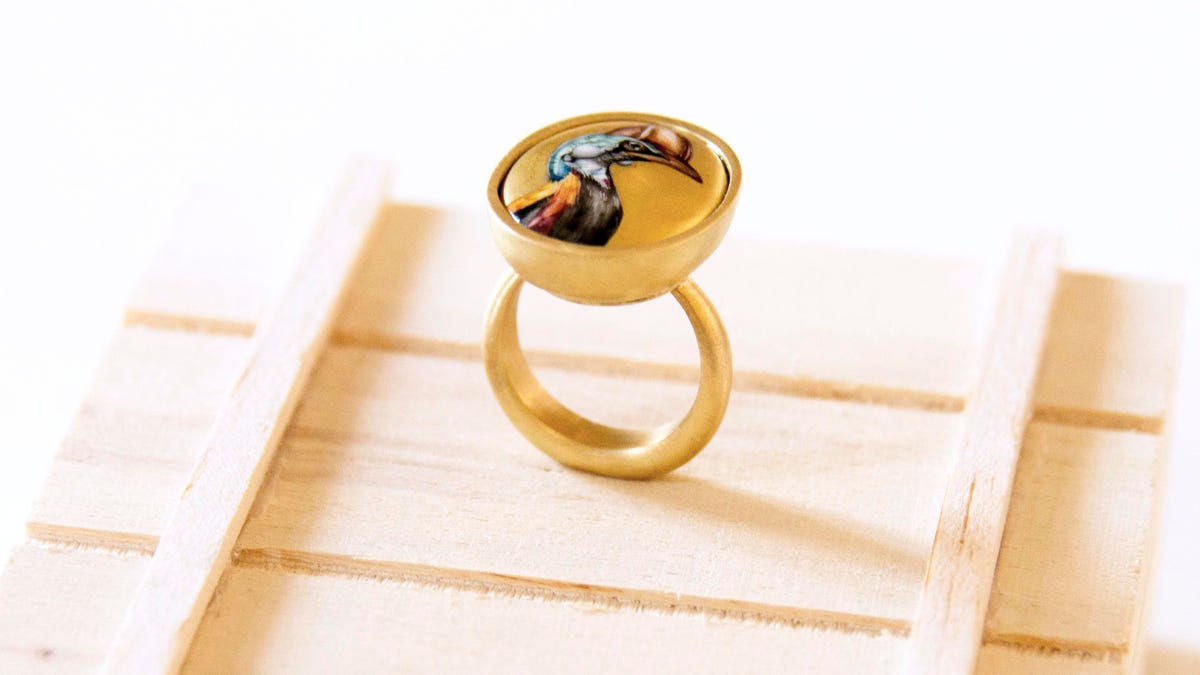[ad_1]
Named after Swedish botanist and zoologist, Carl Linnaeus, Veronica Lenza’s Milan-based Linneo brand mixes gold and porcelain onto which she has hand-painted miniature drawings of plants and animals. Having studied fine art and art history at Brera Academy in Milan and art, film and photography at London’s Kingston University, the Brescia-born, self-trained jeweler collaborates with Milanese craftsmen to manufacture her one-off handmade pieces.
One-of-a-kind Linneo gold ring with ink and gold on porcelain plate designed and handcrafted by … [+]
How did you arrive at this calling? How and when did you become interested in jewelry, and when did you know you wanted to be a jewelry designer?
Jewelry making, for me, is a means, not an end; in fact, I wouldn’t say I have a vocation for this profession, but that I found in jewelry the context for my explorations. It all started from my drawings; I have been projecting photos onto bodies, sketching tiny scenes and subjects around fingers, ears, wrists, legs. I never thought of those layers as separated objects from the body, not even as separate items between them; they were a discourse, a visual chant, a progression of ideas. I liked that they were always under my eyes, intercepting sights when I was gesturing and talking, even when distracted. Those drawings were there to give glimpses of leisure, also when you didn’t think about their presence. When I started thinking of making jewels, it had a functional purpose: a framework for my thoughts and a way of wearing and then removing them.
What are your sources of inspiration? How are you adopting a different approach and mentality to jewelry making, away from traditional jewelry?
My primary source of inspiration is the urgency to think about our planet’s incredible and surprising common heritage. I always start from nature, an inexhaustible source of surprise and emotions, deserving of all our respect. I also look to artifacts made by prehistoric humans: objects and personal ornaments representing the habits, discoveries and first forms of spirituality, and often having a symbolic communication function. I’m still close to this idea. I’m a jewelry designer because I create an object classified as a jewel. Still, each jewel is part of a whole. They can hardly be separated from each other, like words. They have their meaning, but they are a unitary discourse for me. The idea of the name Linnaeus (August Strindberg wrote: “Linnaeus was in reality a poet who happened to become a naturalist.”) also comes from this. The concept of cataloguing, building a semantics of relationships or associating by subtraction or similarity.
Linneo one-of-a-kind gold brooch with silver and ink on porcelain plate designed and handcrafted by … [+]
What is your approach towards gold, and how is this reflected in your jewelry creations?
Gold was often used to fill in backgrounds in paintings. As unearthly light, gold leaf was associated with the sun and at the same time a symbol of incorruption and immutability, of everything sacred and eternal. These qualities are tangible when you start working with it and learn its physical properties that make it a symbol and a matter of desires. My approach is minimal; I try to give a shape and reduce finish. In reality, I like gold’s presence: in a world where lightness is a marketing keyword, it resists and has an ancestral power simply by its specific weight.
Where do you source your gold? Is it ethical or recycled gold? Is this important to you?
I rescue jewels that are hopeless. I wish to accelerate the recapture of the meaning of used gold by framing new stories around it. My work does not aim to restore a lost past, but instead proposes to move into a future where resources are finite. I think a circular economy is a responsibility for everybody who produces clothes, goods or jewels. We have to reduce consumption, be imaginative about how to transform what we don’t use anymore and value the history of objects and materials themselves. New gold is beautiful and I use it sometimes, but I think that the quality of the material lies in its intrinsic capacity of being recast and remolded.
Italian jeweler Veronica Lenza in the studio
What new innovative techniques or technologies do you incorporate in your jewelry making, and who are the artisans you work with?
I mix ceramics and gold. Both are fascinating materials in many ways, but what gives me great satisfaction is the magic that is created in their union. The contrast between the opacity of unpolished gold and the iridescent sheen of glazed ceramic becomes an all-round esthetic component. It translates into an unprecedented relationship between decorated porcelain and precious metal. I think I can only achieve some details by using my hands. Something handmade is not perfect, thus more fascinating than a super perfect, super shiny piece, identical to many others. I make one-of-a-kind jewels.
[ad_2]
